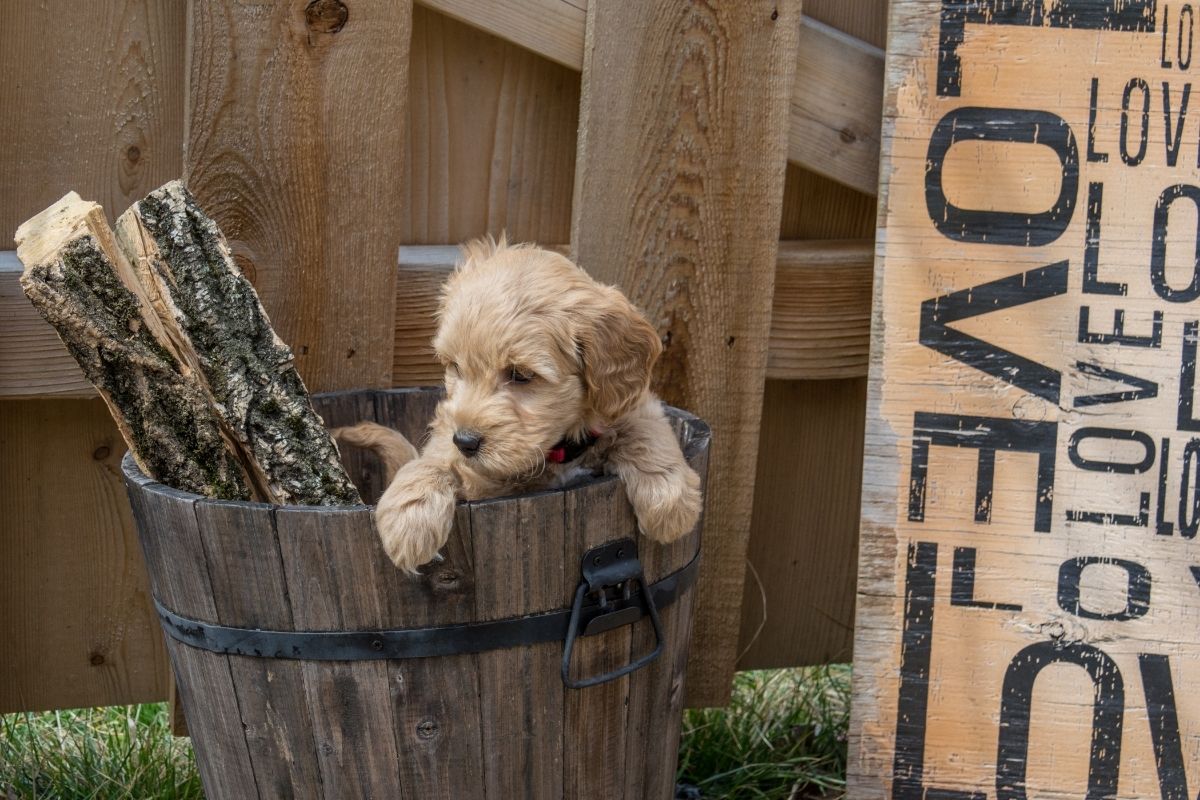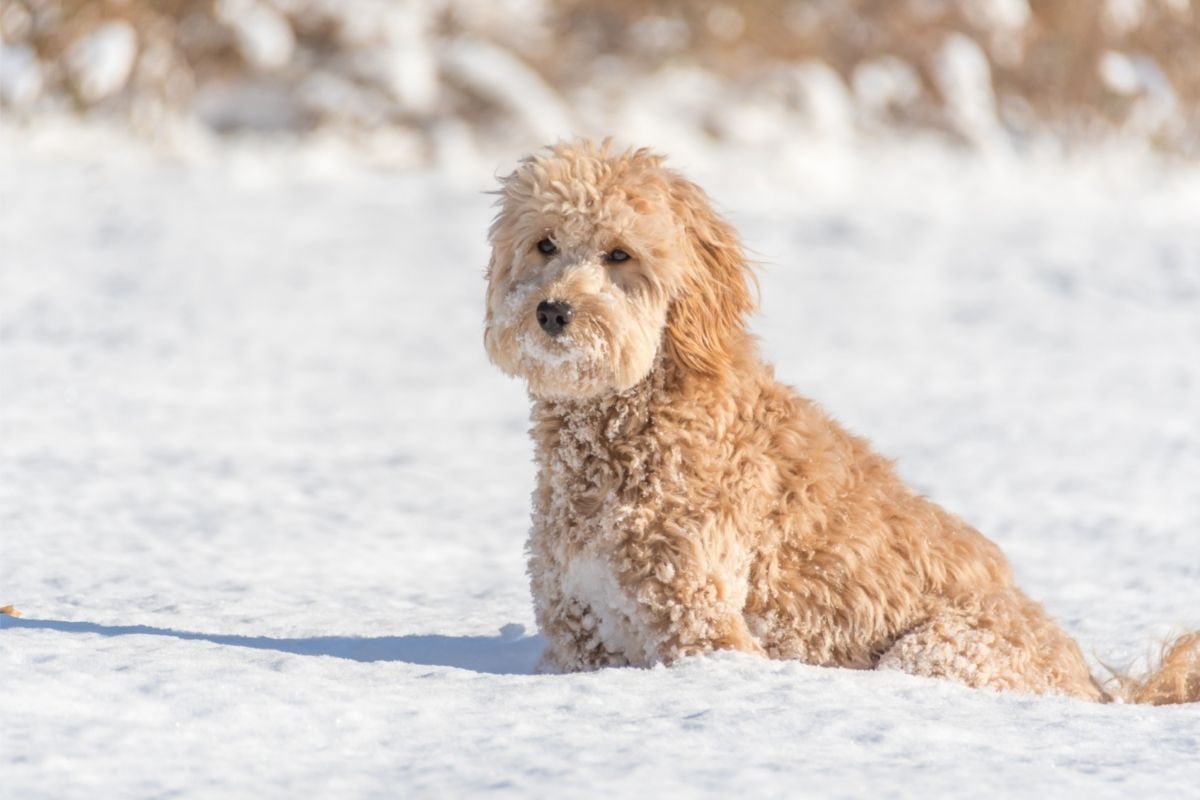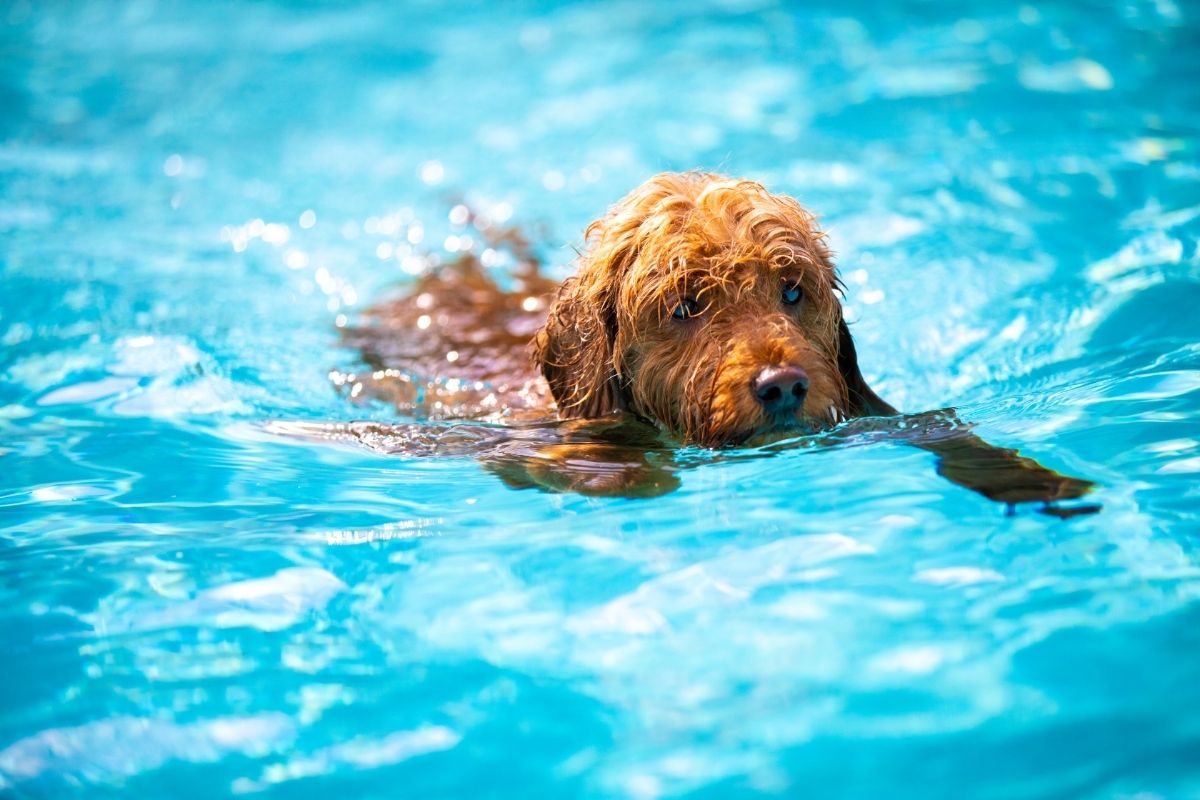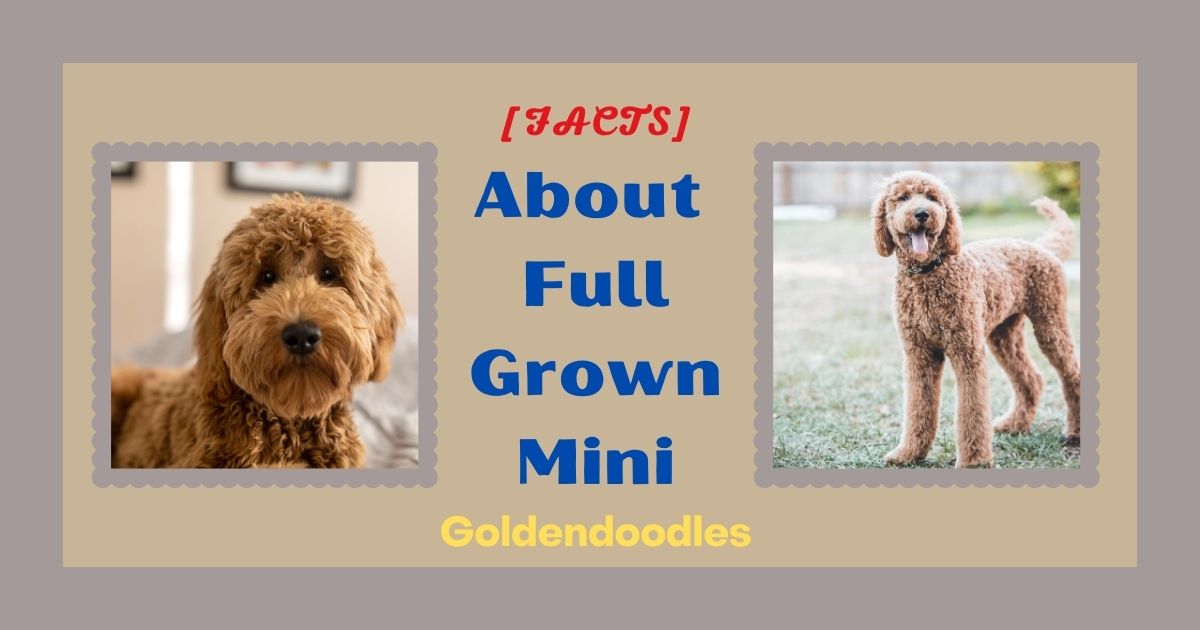What is a Mini Full Grown Goldendoodle?
You may have heard about it and wondered what a full-grown Mini Goldendoodle is? The name reveals some of it, but there might be plenty you don’t know. Don’t worry; that’s what we’re here to shine a light on.
A Goldendoodle is a cross between a Poodle and a Golden Retriever, with many considering the Mini Goldendoodle the smaller cousin to the famous so-called Goldendoodle.
A Miniature Goldendoodle will, however, as the name suggests, often be more petite than the Standard Goldendoodle as it is a mix with a Miniature Poodle and a Golden Retriever. What else is there known about this new type of dog? Continue reading!

A Guide To Buying a Mini Goldendoodle
There are a few things to be aware of when you want to buy a Mini Goldendoodle or another Goldendoodle size. A Goldendoodle is not an actual breed; it is a “designer mutt.” Hear me out: That does not mean they can’t be lovely and wonderful dogs, but it is not an actual breed.
Not everyone likes pedigrees or wants a dog with one. That is entirely fair and up to the individual dog owner. However, it is good to remember that, as Goldendoodles are not a registered breed, there are no regulations on breeders breeding these Mini Doodle dogs or other Goldendoodles.
There are plenty of ethical and excellent breeders but beware when you buy Mini Goldendoodles. Unfortunately, some scrupulous people have caught on to the fact that these dogs have become immensely popular and can therefore sell for vast sums.
It means that some breeding of dogs without proper health testing happens. Sometimes with puppies born into horrible conditions and a much higher risk of developing diseases. It is not the case, at all, for all Goldendoodles or other doodle-types, but it is essential to ask the right questions of your breeder before buying Mini Goldendoodle puppies.
Some sound advice before buying any puppy:
- Ask about health screening: We will cover further what diseases are specific for Goldendoodles. But, always ask any breeder whether both parents have received proper medical care throughout their lives and are properly health screened.
- See the parents: A reputable breeder should have no issues showing off the puppies’ parents. The father may live somewhere else, which is perfectly normal, but the mother should be available for you to meet.
- See the puppy before buying it: It is essential to see where the puppy will live for the first weeks of their lives. Again, a reputable breeder should be okay with showing you the puppy area.
- Ask for professional advice: Ask your veterinarian, dog trainer, or similar professional whether they know of any breeders to contact – or some to avoid. They may not be able to say it straight out, but they might be able to point you in the right direction.
- Ask for personal advice: Ask friends and family if they have any experience choosing the right breeder. Just note that some may have the perfect dog, even if it didn’t come from the right circumstances – so make sure you still do the legwork and check out the breeder.
- Talk to the breeder: Although there are unethical breeders out there, there are also many breeders that are professional, ethical, and hardworking. You will often recognize these because they love talking about their dogs, puppies, and breeding – the good and the bad. They are just passionate about their dogs.
.
With all the worry done, let’s get on with it and look into what a full-grown Mini Doodle is and everything else you might need to know!
How Big is a Full-Grown Mini Goldendoodle?
I think we can all agree that Mini Goldendoodle puppies are adorable – and luckily, most people also find that their Mini full-grown Goldendoodle is also quite cute!
As it is not a registered breed, there are no standards for how full-grown Mini Goldendoodle puppies will look or how big they will be. But there are fortunately ways to estimate how big a small Goldendoodle will become.
However, as a Mini Goldendoodle is a mix between two entirely different breeds, it means that breeders will generally estimate that a full-grown Mini Goldendoodle will be between:
- 13 to 20 inches (33 to 50 centimeters).
- 15 to 40 pounds (7 to 18 kilograms).
Yes, that is quite a stretch; we know that, but that is a general estimate. Continue reading if you want to learn more about how to determine (with perhaps a bit more accuracy) how big Mini Goldendoodle puppies will become.
At What Age is a Mini Goldendoodle Full Grown?
It is a common saying that a dog is physically fully grown when they’re a year old and mentally fully grown a little later. It makes sense, though, that your dog won’t wake up on its first birthday and suddenly be all adult and will never change from here.
Maturation, physically and mentally, is a process dependent on socialization, breed, and size. It can be challenging to determine when it comes to a mixed breed like a Mini Goldendoodle.
As a rule, larger breeds generally mature later than smaller breeds. A golden retriever is considered a large breed. Typically, they will reach their full adult height when they’re nine to twelve months old. It will take them longer to fill out and reach their total weight.
On the other hand, a Miniature Poodle is a smaller breed and will finish growing when they are between seven and ten months and fully grown when they are no more than fourteen months old.
A dog is fully grown when the growth plates within the bones have fused. Depending on which one of the parent’s dogs your Mini Goldendoodle takes most from, you should expect that your puppy will be physically fully grown when it is roughly one year old.
Whether your Miniature Goldendoodle is fully grown is, in most cases, primarily relevant if you want to start running with your dog or otherwise use it for intense exercise. If you are in doubt, we recommend that you contact your veterinarian; they will be able to guide you thoroughly.
What Impacts the Height and Weight of a Mini Goldendoodle?
Size is often an essential factor when future owners consider what dog breed they want to bring into their house. Mini Goldendoodles are often more miniature than a Standard Goldendoodle. However, it can be exceedingly difficult to determine the final size of the dogs as you’re mixing two very different breeds.
Genetics is the number one thing that affects how big a dog will become, but other aspects can also influence how big a Mini full-grown Goldendoodle will be.
Gender
On average male dogs are larger than female dogs, with some variation between breeds in how much bigger. In most cases, a male dog will, on average, be about 10% bigger than a female dog.
Nutrition
Feeding your puppy proper nutritious food – or the opposite – will inevitably affect how big it becomes. For example, a dog isn’t receiving enough proteins or will often have less muscle mass, making them smaller. Lack of other nutrients can also lead to your dog being smaller than their genetics may suggest.
Let’s get back to the genes, though! For several decades scientists have been working on mapping the genome (the whole “map” of genes) of humans and dogs. Some of the knowledge gained from this mapping shows us how the genes impact the size of a dog.
If we get nerdy, there is a specific part of the canine chromosome 15 (CFA15) that shows a strong association with the dog’s body size, and concerning this, a gene called the IGF1 gene that affects how big a dog will become.
The chromosome and the genes are inherited from the parents and show directly that the genetic component primarily affects how big it will become.
Looking at it in another way, we could also state that; if genetics did not influence how big a dog would become, a Chihuahua could, in theory, become as large as a Great Dane. As it doesn’t, genes must play a massive part in how big our dogs become.
It goes to the reason that a Miniature Poodle and a Golden Retriever will not have the same or even very similar genes for size – as they are very different in size. How big their offspring then becomes can vary a lot, as each offspring is a combination of their parent’s genes. That is why Goldendoodles are so varied in size!
The “generation” of your Miniature Goldendoodle also plays a role in making matters even more confusing. When we talk about mixed breeds, some breeders have started referring to the offspring in generations. A first-generation Goldendoodle mixes a Poodle and a Golden Retriever – an f1 Goldendoodle.
However, if you mix a Goldendoodle with another Goldendoodle, their offspring becomes f2 – second-generation Goldendoodles. It would make sense that it should be easier to determine the f2 Mini Goldendoodle full-grown size. It is, and it isn’t.
It is true that statistically, the f2 Mini Goldendoodle puppies will be more likely to be the same or very similar size to their parents. But don’t forget that both parents still carry the genes to be smaller and larger! A large gene from the original golden retriever may suddenly appear in an offspring, even if this is second, third, or even fourth generation!
In the end, when you are buying a mixed breed, even one bred from other Goldendoodles, you will have to accept a particular risk of the dog becoming smaller or larger than you anticipated.
What is the Difference Between a Mini, Toy, and a Teacup Goldendoodle?
We have already talked a lot about size and genes, especially how difficult it can be to determine the size of a full-grown Mini Goldendoodle as many factors play a role.
There are, however, also different types of Goldendoodles – with some of them likely to be even smaller than the Standard Goldendoodle. The other sizes of Goldendoodles are “made” when you breed a smaller Poodle type with a regular Golden Retriever.
Poodles come in three officially recognized sizes:
Genes are funny things, and you can’t always predict how they will act, but it goes to reason that if you have more “small” genes thrown into the pool, it is likely that the offspring will become smaller as well.
A small Golden Doodle is the Toy Goldendoodle or the Teacup Goldendoodle, practically a micro Goldendoodle. The Toy Goldendoodle will be 13 to 20 pounds (6 to 9 kilograms) and 14 to 15 inches (35 to 38 centimeters) tall.
The Teacup Goldendoodle is even smaller at 13 pounds or less and 9 to 12 inches tall. Be aware when you buy these small Goldendoodle puppies, though, as some breeders will put size over health.
An f1 Mini Goldendoodle is a first-generation Golden Retriever mixed with a Miniature Poodle. Although smaller than the medium and standard Goldendoodle, it is on average 15 to 40 pounds (7 to 18 kilograms) and 13 to 20 inches (33 to 50 centimeters) tall.
What Does a Mini Goldendoodle Look Like?
Have you ever seen a Poodle? You may be picturing a show Poodle right now with a very narrow nose. That is, however, rarely what “family” Poodles look like. If you have seen a Poodle with the same length fur all over, that is probably most likely what your full-grown Mini Goldendoodle will look like.
Mini Goldendoodles can, however, look like everything between a Poodle and a Golden Retriever. There’s no definite way of knowing until they come out. Most Mini Goldendoodles will have some curly-haired fur from the Poodle, but how much can vary a lot, and beware – there is no guarantee that your Mini Goldendoodle is allergy-friendly.
The Poodle is allergy-friendly because it carries genes for continuously growing fur/hair. That means it will need frequent trims. Golden Retriever has “regular” dog fur genes with a thick furry undercoat.
Which of these genes your Mini Goldendoodle puppy will carry you cannot know until it is born, and even then, most dogs won’t have their final fur until they are adults. Depending on the generation, your dog may take mostly from its Poodle parent (or grandparent) and have tight curls that never shed and are considered hypoallergenic.
On the other hand, it may also very well take mostly from its Golden Retriever genes. It may even have a combination of both giving it tight curls that sheds a lot – there’s no way of knowing.
Even several generations in, with primarily hypoallergenic Mini Goldendoodle parents, the genes may appear and change the next generation of offspring – although the changes are less, of course, several generations in.
If someone promises you that your Mini Goldendoodle is hypoallergenic, just know that this is not guaranteed. It’s all in the genes. No matter what specific type of fur your Goldendoodle ends up with, it will almost certainly have a coat that can grow to be very long and will therefore need frequent trips to the dog groomer – or you can give it a go yourself!
Another thing controlled by genes is color. A Mini Goldendoodle can be born in a variety of colors. Some are even multicolored! The most common Goldendoodle colors are:
- Cream
- Red
- Golden
The most popular colors are the very light creamed colored puppies. Don’t let the puppy-dog eyes fool you. Underneath this adorable exterior lies a very high-energy dog.

The Temperament of the Mini Goldendoodle
If there is one word that would describe a Mini Goldendoodle, it is extrovert.
Of course, each dog is unique, with its unique personality that can develop in many different directions. But, as a general rule, all Mini Goldendoodles tend to be very friendly, outgoing, and easygoing.
Most commonly, a Mini Goldendoodle will want to say hello to everyone you meet on a walk, dogs, humans, and even other animals – everyone is a friend!
That’s what happens when you mix two very sociable breeds. Although some more Miniature Poodles can seem stand-offish, most Poodles tend to be very friendly. The Golden Retriever is even more so – it makes for a pleased dog, most of the time at least.
It also makes for a very energetic dog breed. Both the Poodle and the Golden Retriever are working dogs meant to retrieve items from water. Goldendoodles often inherit the high energy and stamina of both breeds and the brilliant mind of the Poodle—some more than others, of course.
It would help if you offered your Mini Goldendoodle plenty of physical and mental stimulation; otherwise, it will become a nuisance. It may even display unwanted behavior like barking, chewing, and even aggressiveness. Play, dog training, and enrichment toys are the way forward with these intelligent and active dogs!
Goldendoodles are often a very happy-go-lucky breed. If they are socialized correctly as Mini Goldendoodle puppies, they will likely get along with most other dogs. Just remember to supervise them around small children and other animals as they can become quite forceful in their affection and teach them to moderate their excitement.
Also, remember to teach your bouncy Mini Goldendoodle good vet-manners from a young age. Like all dogs, they will need visits to the vet, which is much easier if they know to have their teeth and ears checked from puppyhood!
That is lovely if you are looking for a new best friend that will follow you everywhere. Less so when that codependency turns into problems.
Luckily, you can teach most dogs to be home alone for some amount of time – that goes for the Mini Goldendoodle as well. Start the training from a young age, consult a specialist if you have troubles, and hopefully, you will have no issues!
In the end, if you are looking for a dog that will (most likely) love you and your family (as well as the neighbor, the mailman, the birds, and that other dog you pass once every six months), then the Goldendoodle is perfect for you!
Do Mini Goldendoodles Bark a Lot?
Once again, it will depend a lot on your unique dog. However, as Mini Goldendoodles are such happy dogs most of the time – they also tend to be quite loud dogs. It is considered a pretty verbal breed.
You can, of course, train dogs to impulse control and thereby bark a little less. It is, however, nearly impossible to teach a verbal dog to be completely quiet. If you live in an apartment complex with thin walls, the Mini Goldendoodle may not be the best breed for you. They are bound to be a bit loud at times with all their excitement in them!
Do Mini Goldendoodles Shed?
The promise of a non-shedding breed entices many future owners. A reputable breeder should be upfront about this. Your Mini Goldendoodle will likely shed less than other breeds.
Suppose you consider a Mini Goldendoodle because you or your family has allergies. In that case, you must spend time around other Goldendoodles before committing to buying a Mini Goldendoodle puppy to minimize the risk of having to rehome the dog later.
Just remember, even puppies from dogs that are in all aspects hypoallergenic may turn out to affect your allergies. Suppose you want a hypoallergenic dog. In that case, you should consider getting a pure Poodle or other proven hypoallergenic breeds.
Allergies aside, Mini Goldendoodles will likely shed less than other double-coated breeds—a massive bonus for many owners. However, less shedding does not correlate with less grooming. Goldendoodles are famous for needing a lot of grooming to prevent matting and other hairy issues.
Don’t worry, though; brushing and even trimming with a machine is not nearly as difficult as it looks. If you are willing to study some videos and can live with your dog, sometimes looking a little odd while you are still learning, you can trim your dog at home – just make sure you invest in a good trimmer, or it will take you all day!
Health Problems Associated With Mini Goldendoodles
As a future veterinarian, one of my biggest concerns about Mini Goldendoodles – and all the other Doodles that have appeared the last couple of years – isn’t that they aren’t wonderful dogs. They are too frequently not appropriately bred, resulting in unhealthy puppies.
The number one key to having a healthy Mini Goldendoodle is finding a good breeder who knows the risk of breeding two quite different breeds together and has done their job correctly.
Both parents should be thoroughly health checked, screened for genetic diseases, and preferably have had a mental evaluation done before being bred – that makes for healthy puppies.
Even with all the proper tests done, there are still some diseases your dog may risk suffering from. The most important of these are:
- Patellar luxation: A loose kneecap.
- Hip dysplasia: Progressive and painful degeneration of the hip joints.
- Progressive Retinal Atrophy (PRA): An eye disease that will lead to blindness.
- Hypothyroidism: An endocrine illness.
- Von Willebrand’s Disease: A blood disease that causes the blood to lose its ability to clot properly.
All dogs may become sick or get hurt, but thorough testing and frequent prophylactic trips to the vet prevent many diseases from becoming severe. An apple a day is not quite enough to keep the animal doctor at bay. It takes work from all involved.

Conclusion
The Mini Goldendoodle has fast become one of the most popular breeds out there, and for good reasons. These fluffy goofballs often adore their human companions, are easy to train, and have the energy to come along for any adventure you may wish.
Just remember to always look for a good breeder to ensure you and your new best friend will have many years together!
